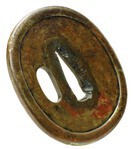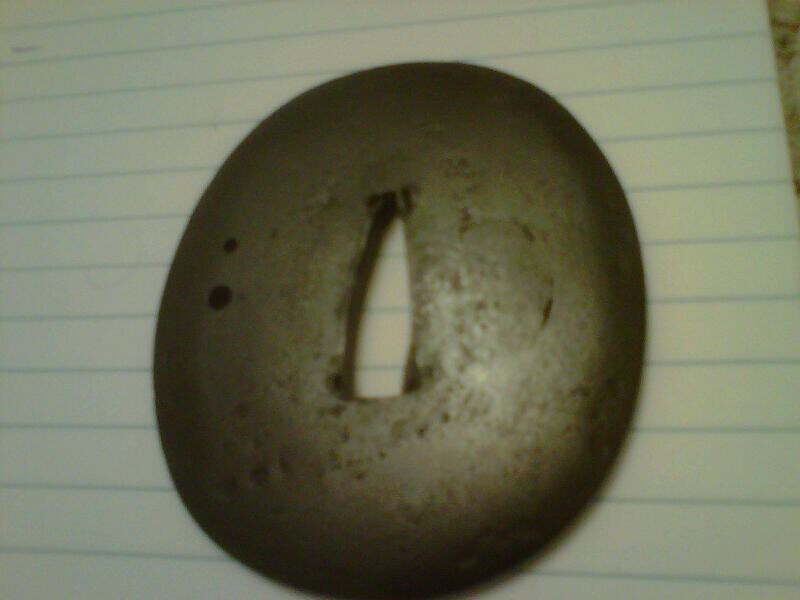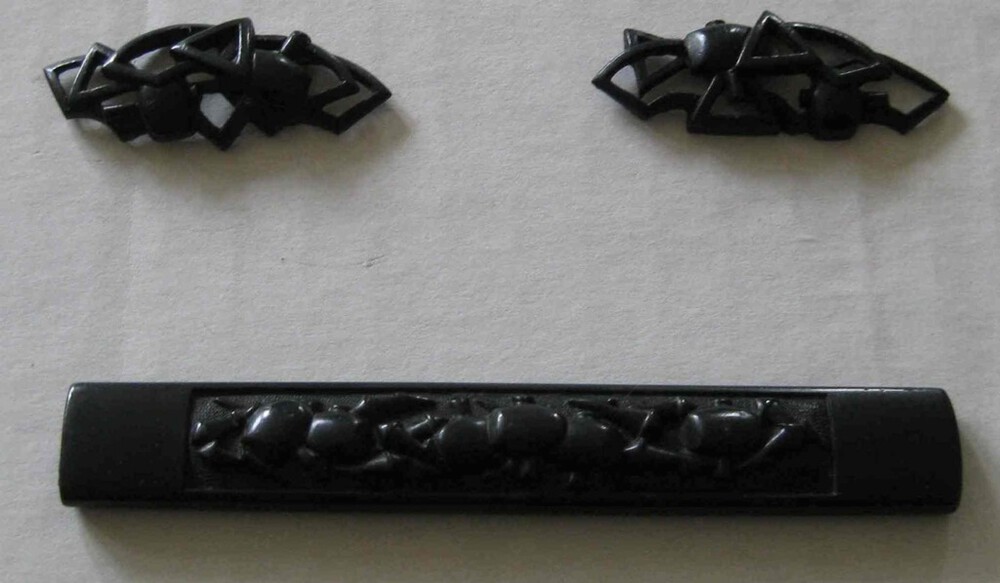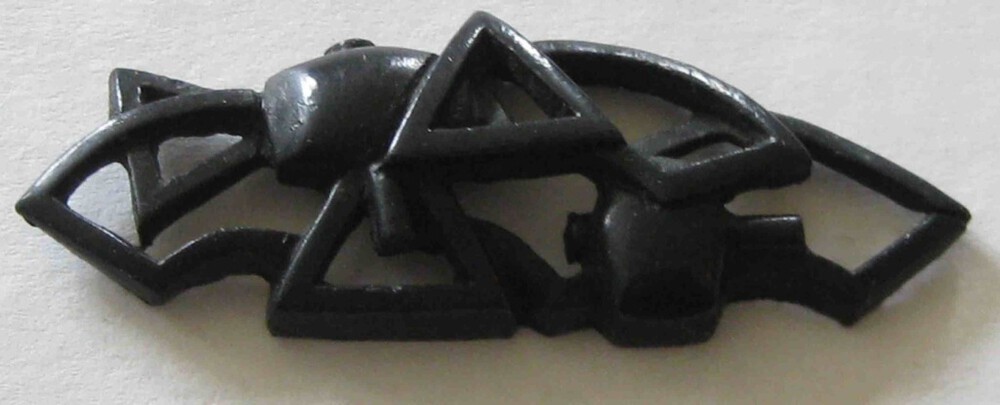-
Posts
2,281 -
Joined
-
Last visited
-
Days Won
17
Content Type
Profiles
Forums
Events
Store
Downloads
Gallery
Everything posted by Toryu2020
-
Stu - If I had to say I would venture that it is no more than 100 years old maybe 200. Tsuka and saya were used up with everyday wear and most of what we see is late Edo or Meiji work. The fittings do look like they could be older, but to my eye the wood is pretty fresh... -t
-
Keith et al - I'm inclined to say this is 20th century - the fittings are older but the weave, color and style of wrap suggests to me later work. Pre-war certainly but not much older. The key actually though is in the wood itself. Can you show us a photo of the wood under the fuchi and the inside of the handle? The true age will be readily apparent I believe... -t
-

Japanese swords, samurai, thesis discussion
Toryu2020 replied to tiarnol's topic in General Nihonto Related Discussion
First I would seek out the Samurai-Archives for a quick source of good information online - Next you might contrast the Bushido of the Kamakura Period with that of the Edo period and that of the Pacific War. The swords were different in shape and size, worn in different ways, and thought of very differently in the society of the times. A big idea perhaps but with a very few simple examples you could easily illustrate this idea - the hard part will be finding good examples of sword and armour from the earliest period... -t -

Dai Token Ichi 2010
Toryu2020 replied to Jean's topic in Sword Shows, Events, Community News and Legislation Issues
Read below for a chance to get translation of another sort... "I just wanted to give a heads up to those coming over for the Dai- Tôken-Ichi at the end of the month. This year marks the 100th anniversary of the founding of the NTHK. We will be holding the following event not far from the site of the DTI: The event is on Sunday, the 31st of October at the ANA Intercontinental Tokyo Hotel near Roppongi Itchôme station on the Namboku line; however, it should be a short taxi ride from the DTI. There will be a display of important swords from 2 until 4 and a dinner party from 4 until 6. The display is ¥5,000 and the dinner is also ¥5,000. We will also be giving everyone a copy of the first volume of the Yûshûtô Zuroku. If I know how many of you will be coming, I will try to toss in the translation. I hope some of you can make this. It should be fun. I will be at the DTI in the morning and anyone who wants to go can grab me and I will arrange transportation." on behalf of Gordon Robson robsongo@swu.ac.jp -
As if there was not already enough to do... "I just wanted to give a heads up to those coming over for the Dai- Tôken-Ichi at the end of the month. This year marks the 100th anniversary of the founding of the NTHK. We will be holding the following event not far from the site of the DTI: The event is on Sunday, the 31st of October at the ANA Intercontinental Tokyo Hotel near Roppongi Itchôme station on the Namboku line; however, it should be a short taxi ride from the DTI. There will be a display of important swords from 2 until 4 and a dinner party from 4 until 6. The display is ¥5,000 and the dinner is also ¥5,000. We will also be giving everyone a copy of the first volume of the Yûshûtô Zuroku. If I know how many of you will be coming, I will try to toss in the translation. I hope some of you can make this. It should be fun. I will be at the DTI in the morning and anyone who wants to go can grab me and I will arrange transportation." on behalf of Gordon Robson robsongo@swu.ac.jp
-
Skull and Bones and Flowers not a match? Natsu gusa wa tsuwamono dono ga yume no ato or The summer grasses, for brave young warriors the aftermath of dreams... -t
-
Ken - This has three drawers - the top drawer is for swords in koshirae - you may not be able to see it in the photo but the rack on the right where the kurikata and saeo would be is much larger than the one to the left which hold just the saya. The bottom drawers have racks that are equal in size both left and right slightly smaller than the top drawer, able to accommodate koshirae as you can see but clearly for shirasaya... Best of luck with your project, -t
-
It is my belief that many so called katanadansu are simply long-drawered storage boxes. A proper katanadansu has the fittings in the drawers. Many I have looked at show the shadows and staining where the fittings once were but these have been removed either by Japanese families who found better uses for the tansu or by Americans who couldn't figure out how to get their wine into the "racks." Took me 25 years of looking but I finally found this baby, a very late very rough piece of furniture but with all the fittings intact... -t
-
-
Ouch! Ford - I can see it working either way, however even in your photo the right thumb and index finger are more open, from the front if you had x-ray vision the bones would appear "flatter". As someone else pointed out there appear to be one or two bones missing. Now if you flip it, and imagine the left hand gripping a saya, not only would the hand be tighter around the saya, so that you are looking almost straight at the top of the fist, you can count the four bones of the index finger, and two bones for the thumb, and most important, the long bones in both the thumb and index finger appear exactly where you see them in the hand, no need for artistic interpretation. I suggest "Natsume Han-tamago" or "soft-boiled summer egg" which is the term in Tosa Eishin Ryu for the proper grip on the koiguchi... -t
-
"the original is actually signed on the ura..." The experts are not artists and artists may not be swordsmen; the grip shown with the right hand would not be correct in Kendo nor in any of the schools of Iaido I am familiar with (from my own limited experience). However given the original design and placement it would be correct for the left hand on the saya prior to the draw. I love this idea but I am highly dubious. I am looking very much forward to bouncing this off of some Japanese heads to see what kind of sound we get. Ford - do let us know when you've something like this up for sale. I like it in copper but love it in iron! Very nice work indeed, -t
-
Mighty big crabs you got there Ray! And speaking of menuki, we usually see the three crab combo in gold or shakudo copied from early kinko works. This is a very refreshing example, a single crab and of considerable size - I wonder if the one on the reverse gives any indication of being male or female? -t
-
In Japanese there is a practice called ate-ji - the use of kanji that can be read with the target sounding. Thus 中心 two common characters are seen as Chushin for most Japanese readers but as the first can be read "Naka" and the second "Go", among sword enthusiasts we see them as Nakago - and in fact this rendering has become the common kanji used. While it makes an odd sense these kanji may have been chosen simply because they "sounded" right. So then we can see 双子矢間 双児家魔 蓋後山 双子山 All these could be read futago-yama but only one may be an actual place name, the rest nonsense except sounded out they have the right sound. That may in fact be all that the maker was after with his use of the kanji in question. I wonder if the person was not someone unfamiliar with actual signatures of Norisuke and only sounded out the signature using these characters... -t
-
Barry - almost gives it an Umetada feeling, very nice. -t
-
Thanks Malcolm - I see Ian's take on this question, I wonder if anyone knows the origin of the Satsuma appellation... -tom
-
Or so we are told- Is there any evidence or original reference that identifies these swords as definitively made for/during the Satsuma Rebellion? Pieces I have seen are typically poor quality swords, with poor quality fittings very roughly made and usually lacquer that seems to have been a few coats shy of a full job. Some but not all are clearly Satsuma koshirae which is all I think these things are, just poor quality Satsuma koshirae. Hence my question - has anyone seen reference to these in Japanese sources? What are they called in Japanese and what is the rationale for assigning these to the rebellion specifically? -t
-

Sale @ Christies 15/09/2010
Toryu2020 replied to DirkO's topic in Sword Shows, Events, Community News and Legislation Issues
http://tinyurl.com/2chqd35 Don't overlook the sale at Bonham's - nicer armour... -t -
Jamie - Alternately, you might post photos of the sword and perhaps we can help you understand the findings of the shinsa team. This is where real study begins - use all of your resources to see if you can confirm their findings and if not use them to confirm other hypotheses. In the end greater understanding of swords is the goal and you have a terrific opportunity for learning. -t
-
Rare stuff, Not a lot of works coming out of Harima. James you should post photos of the blade if you get the chance, -t
-
Ebay says 61cm your "paper" says 59.6cm... -t
-
Or other of our tsuba experts; How does one cut the hitsu-ana? Below I have attempted to attach photos of a tsuba which I believe to be Satsuma, very simple, iron roundel, nice iron IMO. Upon close inspection one can see the outline of a kozuka hitsu. The metal inside this outline is no different than that of the plate itself. The outline can be seen on both sides of the plate. Not sure the photos can show this but what are we looking at? Is this the beginning of a hitsu-ana that was never cut out or has the maker somehow cut an opening and then filled it with the same steel as the plate? Curious as to your alls thoughts... -t
-
Malcom - Very nice video, thanks for that. Especially enjoyed seeing the work of Ko'Etsu. I don't know if I would say that "mottainai" is an aesthetic term. As the wiki says it means "what a waste" or "what a shame", interesting that some are building a movement around it but I don't believe the Japanese think of phrase in quite the same way... -t
-
-
Labelled as Kakeya Rangaku - Which I would translate as "wood-mallet rangaku" or wood-mallet and fence or a fence of wooden mallets? Not sure exactly but I like the idea of a pile of stakes and mallets as a barricade. A Rangaku btw is a type of castle defense, a barricade made by driving stakes into the bottom of a shallow moat and then tying a stout rope to them in a random pattern. Meant to trip up men and horses as they assault the castle walls. While I appreciate Goto artistry, I have never much cared for their works mostly because of their subject choices. However when I saw this set I fell in love with it because of the unusual subject and the deep black of the shakudo. (sorry the photos do not do them justice) I was only able to find one other depiction of this subject and it too was early Goto work. Hows this for rare?
-
Now if your owl is auspicious then he is sitting on the hoe hunting for all the field mice that will be out and about with the harvest. or The tools are for grave digging and the absence of the owner does not bode well for him... -t









